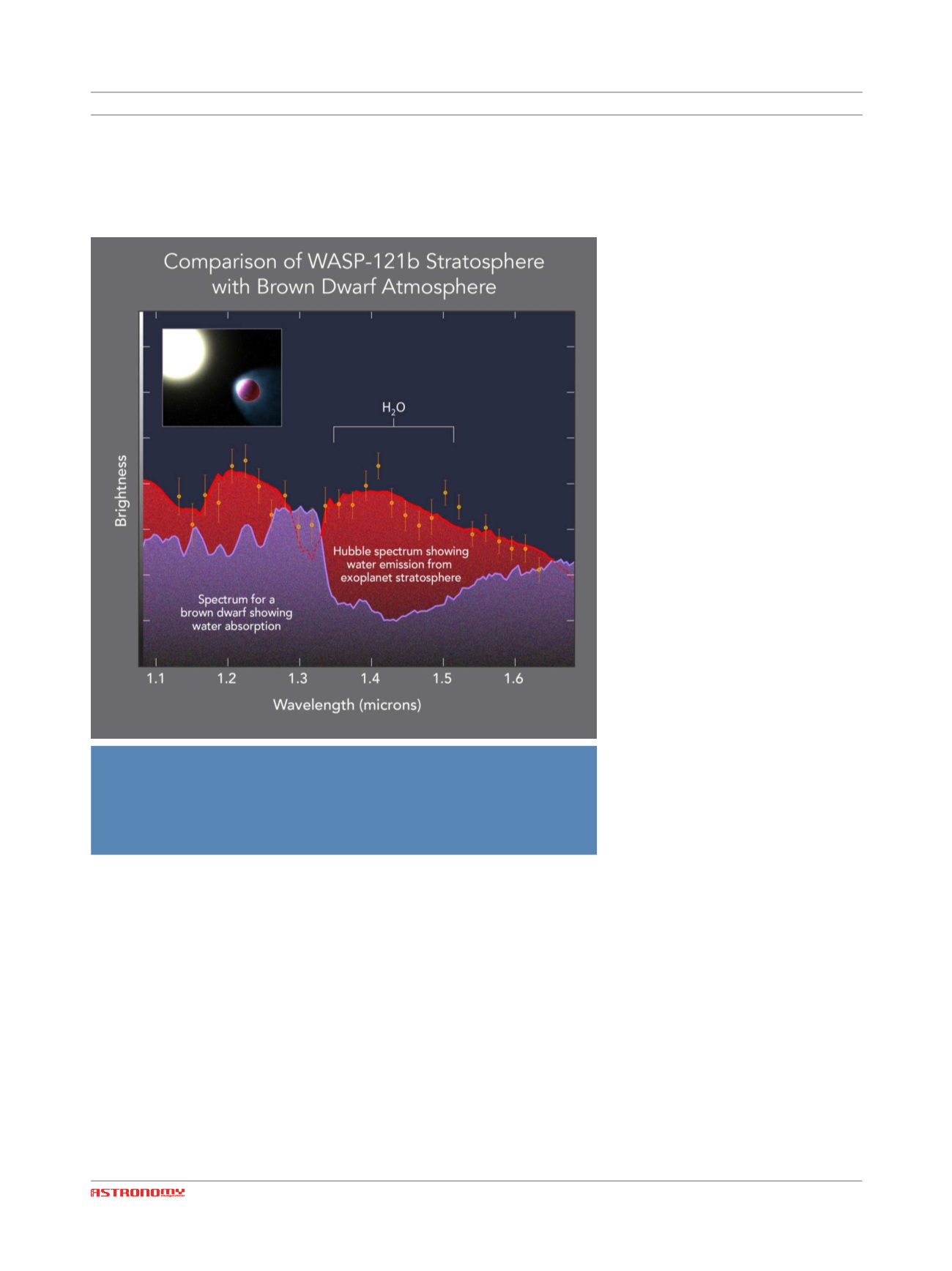

14
SEPTEMBER-OCTOBER 2017
SPACE CHRONICLES
The phenomenon is similar to what
happens with fireworks, which get
their colors from chemicals emitting
light. When metallic substances are
heated and vaporized, their electrons
move into higher energy states. De-
pending on the material, these elec-
trons will emit light at specific
wavelengths as they lose energy:
sodium produces orange-yellow and
strontium produces red in this pro-
cess, for example. The water mo-
lecules in the atmosphere of WASP-
121b similarly give off radiation as
they lose energy, but in the form of
infrared light, which the human eye
is unable to detect.
In Earth’s stratosphere, ozone gas
traps ultraviolet radiation from the
Sun, which raises the temperature of
this layer of atmosphere. Other solar
system bodies have stratospheres,
too; methane is responsible for heat-
ing in the stratospheres of Jupiter and
Saturn’s moon Titan, for example. In
solar system planets, the change in
temperature within a stratosphere is
typically around 100 degrees Fahren-
heit (about 56 degrees Celsius). On
WASP-121b, the temperature in the
stratosphere rises by 1,000 degrees
(560 degrees Celsius). Scientists do
not yet know what chemicals are
causing the temperature increase in
WASP-121b’s atmosphere. Vanadium
oxide and titanium oxide are candi-
dates, as they are commonly seen in
brown dwarfs, “failed stars” that
have some commonalities with exo-
planets. Such compounds are ex-
pected to be present only on the
hottest of hot Jupiters, as high tem-
peratures are needed to keep them in
a gaseous state.
“This super-hot exo-
planet is going to be a benchmark for
our atmospheric models, and it will
be a great observational target mov-
ing into the Webb era,”
said Hannah
Wakeford, study co-author who
worked on this research while at
NASA’s Goddard Space Flight Center,
Greenbelt, Maryland.
T
his diagram presents evidence for the existence of a stratosphere on a
planet orbiting another star. As on Earth, the stratosphere increases in tem-
perature with altitude. The water emissions from the Jupiter-sized planet’s
upper atmosphere show this. The results are in marked contrast to the spectrum
of a failed star, a brown dwarf, which shows water absorption because the at-
mosphere is cooling with altitude increase. [NASA, ESA, and A. Feild (STScI)]
To study the stratosphere of WASP-
121b, scientists analyzed how differ-
ent molecules in the atmosphere
react to particular wavelengths of
light, using Hubble’s capabilities for
spectroscopy. Water vapor in the
planet’s atmosphere, for example,
behaves in predictable ways in re-
sponse to certain wavelengths of
light, depending on the tempera-
ture of the water.
Starlight is able to penetrate deep
into a planet’s atmosphere, where it
raises the temperature of the gas
there. This gas then radiates its heat
into space as infrared light. However,
if there is cooler water vapor at the
top of the atmosphere, the water
molecules will prevent certain wave-
lengths of this light from escaping to
space. But if the water molecules at
the top of the atmosphere have a
higher temperature, they will glow at
the same wavelengths.
“The emission
of light from water means the tem-
perature is increasing with height,”
said Tiffany Kataria, study co-author
based at NASA’s Jet Propulsion Labo-
ratory, Pasadena, California.
“We’re
excited to explore at what longitudes
this behavior persists with upcoming
Hubble observations.”
!
















